Lifeboats on Steamships - 1910
Boats and Life Belts
There are many minor safety devices on the ship, such as life belts with automatic lighting attachments, which become lighted as soon as they strike the water.
These are kept on the bridge. Devices also exist by means of which life belts are cast automatically into the water by a single turn of the wrist; after they have all been released, a light flashes up, indicating this to the officer.
The lookouts are able to keep in communication with each other in case the cry "man overboard" is raised. The news can be wigwagged from end to end; life belts can be thrown over, and a special small boat, which is always kept in readiness, can be lowered at once. The apparatus which makes for safety is inspected daily and is frequently tested.
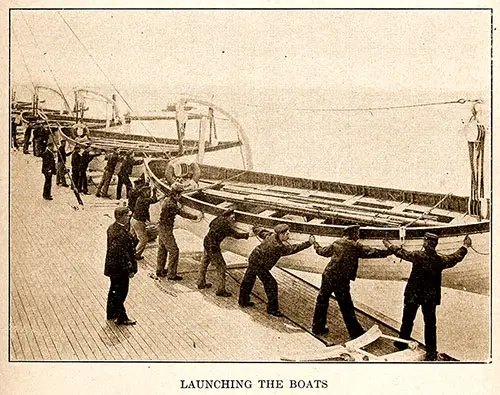
Sailors at Drill to Practice Launching the Lifeboats. GGA Image ID # 17b5a49e74
The lifeboats are maintained in perfect condition and can be launched in an incredibly small space of time, particularly where the quadrant davits are used.
It is a mistake to suppose that the boats are not to be used because they are covered with canvas. This is for their protection. They would soon be useless if exposed constantly to the elements. The crew is very proficient in boat drills, which take place every trip.
Every boat is equipped with a compass, night signals, water, and provisions. Over 90 percent of the seamen, engineers, and stewards on a vessel are proficient in handling boats.
In case of the cry "man overboard" there is immediately released from the bridge a large copper life buoy provided with a calcium carbide tank, which, on contact with the water is lighted so that the location of the man overboard if he reaches the buoy can be readily discerned at night.
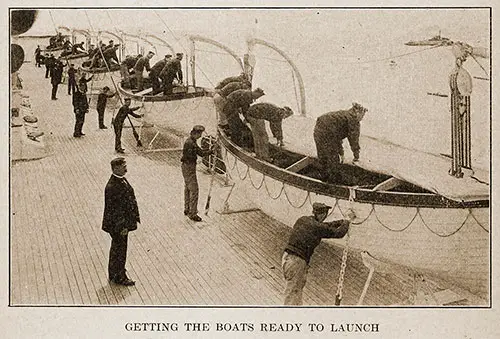
Getting the Lifeboats Ready to Launch. GGA Image ID # 17b5cce2a1
One of the first duties on leaving port is the preparation of a couple of smaller lifeboats, one on either side of the ship, so that they may be ready to render instant succor if the terrible cry of "man overboard" is raised.
For this purpose, they are swung outward on their davits and are lashed to padded poles secured to the davits to preserve them from any injury due to the rolling of the ship.
They are equipped with oars, mast, sails, baler, water breaker, and other necessaries; thole pins and rudder are secured in their places, and the falls, by which the boats would be lowered into the water, carefully oiled so that a single turn of the wrist will cause life rings to drop into the water on either side, both fore and aft, and a warning light indicates to the officer in charge when they have all left the vessel.
Wig-wag signals are also used to locate the supposed person in peril in case of an emergency of this kind.
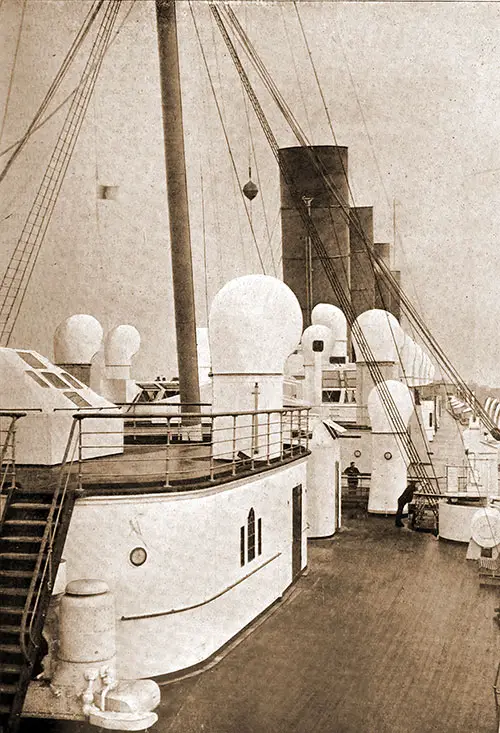
Second Class Promenade on the Boat Deck, Looking Forward, on the RMS Mauretania of the Cunard Line. GGA Image ID # 17b5d51360
Lifeboats are to be carried " in such number and of such capacity as shall be sufficient to accommodate the total number of persons which is carried, or which the ship is certified to carry, whichever number is the greater."
The Board evidently thinks that the largest possible steamship has not been built, for it stipulates that vessels of from 750 to 840 feet in length shall carry not less than twenty-two sets of davits for lowering boats to the water, and shall carry not less than fifteen open boats to be attached to davits.
Those from 840 to 940 feet in length shall carry twenty-four sets of davits and not less than seventeen open boats attached, and those 940 to 1,040 feet in length shall have a minimum of twenty-six sets of davits and not less than eighteen open boats attached.
Still, longer vessels have the number of sets of davits and the minimum number of open boats decided by the Board. The Board also settles the minimum aggregate capacity of lifeboats in cubic feet.
A steamer of 420 to 450 feet, for instance, is to have lifeboats of not less than 6,000 cubic feet aggregate capacity. A lifeboat may be open or decked, as long as it fulfills the rules.
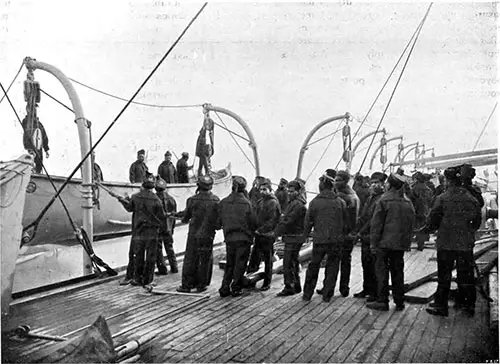
Lifeboat Drill on an Orient Ocean Liner, 1908. GGA Image ID # 17b5dc3f7a
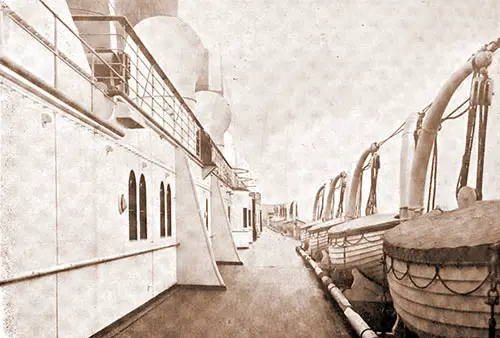
Housing of the Lifeboats on the Boat Deck on the RMS Mauretania, 1907. GGA Image ID # 17b635b4f9
All boats have to be marked with their dimensions and the number of persons they can accommodate, and the word "person" includes not only an adult but every child over the age of one year unless the context of the rules implies otherwise.
Every open boat is to have seating accommodation for as many persons as it is intended to carry. The thwart and side seats must not be more than a certain distance from the boat's bottom boards to ensure the requisite stability and seaworthiness.
The boats themselves may be explained that an open lifeboat is to be two-ended, or pointed at both ends, and shall have for every ten cubic feet of her capacity not less than one cubic foot of airtight and watertight compartments.
A boat constructed of metal has airtight compartments of slightly greater buoyancy to make up for the metal's lesser buoyancy than the wooden boat. Another type of lifeboat provides that a portion of the buoyancy apparatus may be carried outside the boat, slightly below the gunwale.
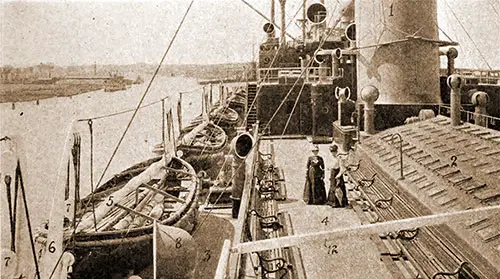
View of the Sun Deck Amidships With More Space To Walk. Note the Lifeboats Along the Left Side of the Photograph. GGA Image ID # 17b69a7ac0
This is usually attached in the form of a fixed fender, and it may be roughly taken that the buoyancy of the interior apparatus is not to be diminished by more than one-fourth, while the total of the interior and exterior buoyancy is to be the same as if the whole apparatus were carried inboard.
A third type of lifeboat is fitted with a strong watertight deck, with, in some instances, enclosed airtight compartments. The other boats may be square-sterned, have a wide transom, and fitted with internal buoyancy contrivances similar to those of the type of lifeboat first described.
One lifeboat in any number carried between four and ten, inclusive, maybe a motorboat, and if more than ten lifeboats are carried, one in every five, maybe a motorboat and an increased proportion may be provided by permission of the Board of Trade under certain circumstances.
In regard to the storage of boats under the new rules, a decked lifeboat may be stowed underneath an open lifeboat, and decked lifeboats may be stowed in sets of three, one above another; this permits of the necessary number of boats being carried without encroaching too much on the deck space available for passengers.
Another important provision, evidently the outcome of the great height at which boats are carried on some vessels, is that when boats are carried on more than one deck, the two different sets of boats are not to foul one another.
About the lowering of the boats, all steamers launched after March 1st, 1913, which have their boats more than twelve feet above the load line disc are to have davits and lowering gear of sufficient strength to lower the boats when fully loaded.
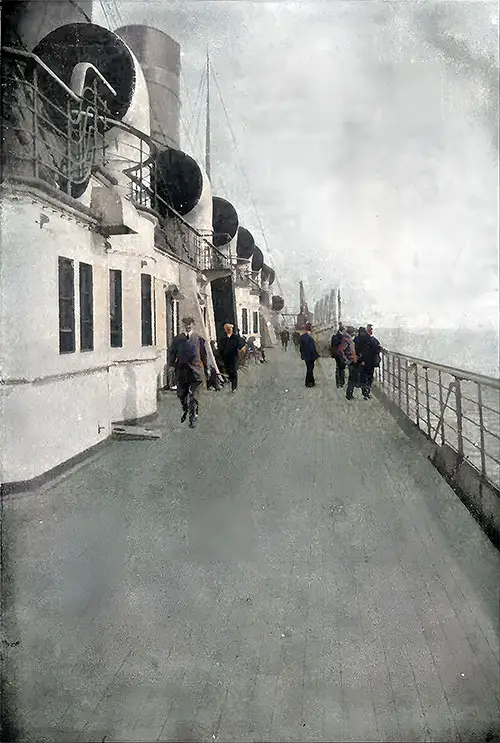
View of the Boat Deck on the RMS Mauretania. GGA Image ID # 17b6ae38a3
In some conditions, rafts of an approved design may be used in lieu of a small proportion of the boats. Most people would not know a ship's raft if they saw one, but that has not hindered some well-meaning enthusiasts from protesting against the rafts at all on a steamship.
They may dismiss as inaccurate the idea that a raft consists of two or three pieces of wooden grating, an oar or two, a couple of odd spars and an empty barrel, all loosely tied together, and that upon this a few unfortunates huddle themselves as best they may until such time as, according to the storybooks, they are rescued.
The records of shipping show that improvised rafts of this character have been the last hope of many and the salvation of few; of the tragedies of thirst and despair and the madness of hunger in its most horrible form, it would be out of place here to write. Where a merciful Providence has dropped the veil of time and forgetfulness, it ill becomes anyone to attempt to lift a corner.
As understood by the Board of Trade and the steamship-owner, the raft is a very different affair from that just referred to. There are several kinds of rafts, all of which have or have had official approval.
One, which was in favor for many years, consisted of two or three long watertight hollow cylinders, pointed at each end and laid side by side, but three or four feet apart.
These cylinders were from about eight to twelve feet long and were fastened between the two sides of a double wooden grating, the idea being that it was equally efficacious either side up.
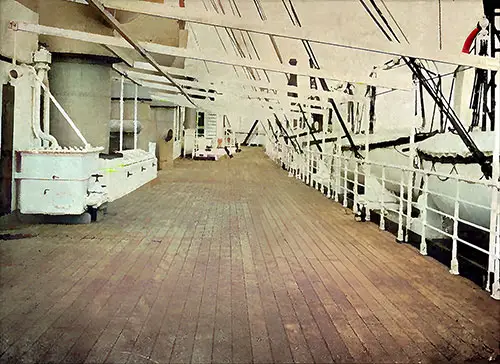
Boat Deck on the RMS Orvieto of the O.S.N. Orient Line. GGA Image ID # 17b6d39048
Being covered only with a grating, it could not be filled with water, and though seas might sweep it, it would continue to float. A mast, sail, oars, some pieces of rope, and a fresh water-barrel were its equipment.
Such a contrivance, though very good in its way, by no means represented finality in the designing of rafts.
Folding rafts or pontoons, folding boats, of which the Berthon is the best by reason of its extraordinary buoyancy for its size when kept in good repair, and steel rafts like pontoons with the inner and outer skin and watertight compartments between the two skins have all been tried with success, and at present rafts or pontoons of the type last mentioned are considered superior to any previous type of raft.
These contrivances have seats, oars, mast, and sails, etc. The usual lockers for storing water and provisions are provided with escape valves to automatically discharge any water that may be shipped. Like all the boats, they have to carry a gallon of water and two pounds of biscuits per head for their occupants.
The idea of a ship's raft, as distinct from a ship's boat, is that it will support a great number of people for its size near where the accident to the ship occurs, to which wireless calls for help will direct rescuing vessels; whereas a ship's lifeboat may undertake a voyage to seek assistance or to meet the rescuing vessel.
Every boat and lifeboat now has to carry, in a tin case for protection against the weather, colored pyrotechnic lights, inextinguishable by water, for use as alarm signals.
Most ocean-going passenger steamers do carry, and in late years always have carried, a sufficient number of boats to accommodate everyone, but it does not follow from this that everyone could be saved in the case of an accident. Several other conditions have to be taken into consideration.
The most important of these is undoubtedly the weather, for if this be unfavorable, it may upset the whole of the arrangements for the lowering of the boats.
This point was lost sight of entirely by a great many people who advocated recently that boats for all on a steamship should be supplied, so as to be able to save the whole of her passengers and crew in case of danger.
In theory, this is all right. Let us see how it works in practice. The best-devised means do not permit a boat to be swung more than a few feet away from a vessel's side.
Suppose the davit swings out with a radius of eight to ten feet, which is quite as much as is practicable. In that case, it follows that, as boats must be slung from their centerline, the space between the side of the ship and the side of the boat will be reduced by at least half the width of the boat; and if a boat has a beam of six or seven feet, the space between the boat and the ship's side is reduced at once by three to three and a half feet.
This leaves a maximum space of only five to seven feet between the side of the boat and the side of the ship.
In lowering a boat from such a height as the boat deck of a modern liner, it must be remembered that the boat has to travel through the air anything from thirty to sixty feet.
And that all the time it is being lowered this distance; it is swinging backward and forwards, and also to and from the vessel, and is gaining momentum at every swing.
The fore and aft momentum may be checked by men with leading ropes, standing at deck openings lower than the boat deck; but it does not do to tighten these fore and aft ropes too greatly, or the boat will be drawn into the ship's side, and the lateral momentum will be increased with the result that the boat may be dashed against the side of the ship and smashed, and its occupants dropped into the water.
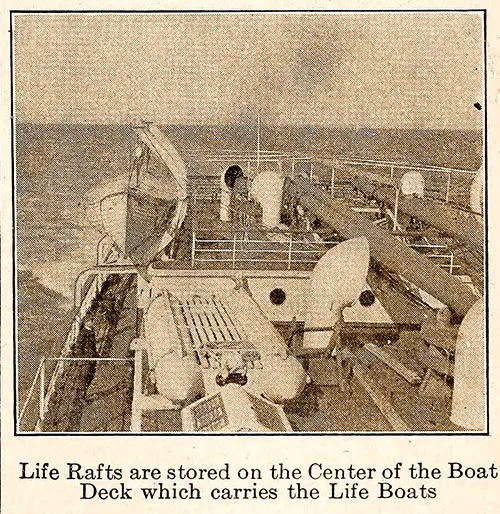
Life Rafts Are Stored on the Center of the Boat Deck Which Carries the Life Boats. GGA Image ID # 17b7e1ebee
The sea is not still, and in most cases to which the boats have to be reported, it is exceedingly rough, and there is always the risk, and a very great risk too, of a broken sea, rising to meet the boat, and tilting it at either end, or catching it on the broadside and upsetting it, or dashing it against the ship.
This is not a fanciful danger, it is an experience that has been witnessed hundreds of times, and no means have ever yet been designed which will enable a boat to be lowered from a ship into a rough and angry sea with perfect safety.
The hooks at the end of the tackle or arrangements of blocks and ropes by which the boat is lowered have not infrequently been difficult to dislodge when the boat has reached the water, owing to the subsiding of a wave and the consequent dropping of one end of the boat.
Sometimes a sailor with presence of mind has been able to sever the rope with his knife, but more often than not, when the hook has remained caught in the ring or sling, the boat has been suspended by that end, and most of its occupants tumbled into the sea and lost.
The great height at which boats are carried increases the probability that the long falls will twist when the tackle is unhooked from the boats, and the ropes are thus relieved of their weight.
If either of the boat's falls should twist, it is frequently very difficult to untwist them and raise them sufficiently far to enable them to be hooked to the inside boat, for the latter to be lifted to the side of the vessel to be lowered to the water.
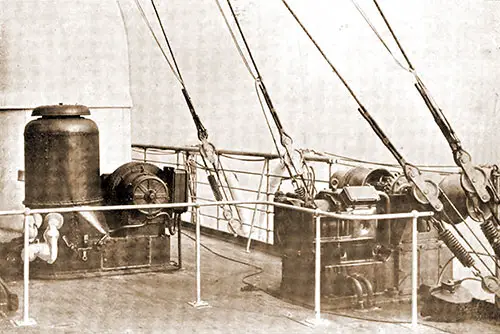
Lifeboat Winch and Thermotank on the Sun Deck of the RMS Mauretania. GGA Image ID # 17b73db970
The longer the fall, the greater the risk of its twisting and this risk is always present, no matter what care may be taken in untwisting the rope when it is rove through the blocks, as its tension is bound to vary with the degree of moisture in the atmosphere.
Hitherto, we have been considering only such circumstances as might arise in the case of a vessel stranding on a sandbank and remaining fast, though comparatively steady.
We have supposed that she is resting upright and that the waves are running in a line parallel to the length of the vessel so that the boats on each side can be used.
But if a ship should happen to run on rocks, she will most likely sustain at once considerable damage to her bottom, and the consequent inrush of water added to the tilting the rocks will probably give her, will cause her to lean over to one side.
If she leans over to the weather side, practically the whole of her boats may be useless.
To begin with, the broken character of the sea, owing to the rocks, will render it exceedingly difficult for a boat to be launched with safety.
The heeling of the vessel would of itself permit the weather side boats to be launched with some facility, but against this, there must be set the great probability of them being swept against the ship's side, and also of them being upset when they reached the water, either by the incoming wave or by the broken backwash thrown back from the ship.
A shipmaster, who, under these circumstances, succeeded in getting five boats out of twenty safely into the water with their full complement of passengers would consider that he had done an exceedingly clever piece of work.
The rougher the sea, the greater the danger incurred in attempting to lower a boat with a large number of people in it, and the greater the loss of life if anything happens to the boat.
In some circumstances, it might be possible to bring the boats round by the stern or bow of the stranded ship, according to which end presented the best opportunities for saving life and lower the passengers one at a time into the boats, but this again is not always practicable.
The boats on the lee side of the vessel, that is the side least exposed to the weather, would be useless, as it would not be possible to lower them into the water without them being swung against the ship's side, as it would take but a very slight heel to neutralize the distance between the sides of the boats and the sides of the ship at the time they are swung clear.
If, however, a vessel in striking rocks or standing on sand, remain upright, or heel over from the weather, the launch of the boats on the lee side becomes a comparatively, though not actually, simple matter.
The danger of the boats being swung against the ship's side is reduced almost to a minimum, for as the boat is lowered, the distance between the ship and the boat increases, and owing to the heel, the boat has to be lowered a less distance.
Again, the stranded hull will act as a breakwater, and the sea on the lee side of the ship will be much less angered than on the weather side.
Under these circumstances, all the boats on the lee side of a ship may be launched, but it will depend entirely upon the circumstances of the disaster, and the consequent decision of the master, whether the boats are launched with their passengers in them, whether the passengers are lowered into the boats as soon as the water is reached, or whether the boats are brought round to some most convenient or sheltered part to receive the passengers.
In these, the most favored, conditions, it is evident that the number of boats which can be launched will not accommodate the whole of those on board.
Nor is it possible to see, as ships are at present constructed, how the boats can be carried so that the whole of them shall be available for use on either side as may be required.
It must also be remembered that a ship's boats are not the light playthings one sees on a river's smooth waters. A ship's boats will each weigh, according to its size and material, anything from a quarter of a ton to a couple of tons, while a ship's dinghy, which is only reckoned a fine-weather boat at best and only holds a few people, will weigh five or six hundredweight.
Therefore, it is not the easiest task to move a ship's lifeboats from one side of a ship to another, especially in a storm, even if assistance can be derived from the numerous derricks with which nearly all ships are fitted.
Some of the largest of a ship's lifeboats will carry as many as seventy-five people, but the majority of the boats will not hold more than thirty or forty, and the seaworthiness of the boat is less, the more number of people in it and the rougher the weather.
In order to secure careful lowering of a boat, whether full or merely with one or two men in it, the boat is sometimes slung from a ring in the center of a chain which passes from end to end of the boat, which when suspended forms, as it were, the base of a triangle.
The exposure to the weather by night and day, and the task of rowing, even if all take a spell at the oar, in turn, are together very exhausting, and at last, the time comes when it is no longer possible to do much more than give the boat enough way to enable her to be steered in the required direction.
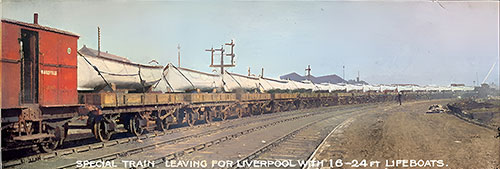
Steel Lifeboats for Ocean Liners Carried on a Special Train Heading Towards Liverpool. GGA Image ID # 17b6d90756
Steel Lifeboats
The introduction of steel as a material for the construction of the boats marked another great advance, and as steel lifeboats do not run the risk of serious damage in the very unusual possibility of oil escaping from the motor and becoming ignited, their superiority over wooden lifeboats is admitted.
Steel motor lifeboats are carried on a number of the latest liners, and in view of their constant readiness for service and the many good points they include a short description of a typical boat of this character may be read with interest.
The boat is twenty-eight feet long by eight feet beam and has a depth of three feet six inches. Like the ordinary lifeboats, it is " two-ended," the two ends being shaped alike, which adds considerably to its seaworthiness and its adaptability for the duties it is specially intended to perform.
Each end of the boat is covered with a wooden deck that is not flat but is curved slightly so that any water which may go over the end of the boat is at once thrown off.
The sides of the boat form the front of each compartment, and this deck is fitted with a wooden bulkhead, and the compartments themselves are provided with buoyancy tanks.
In the fore compartment, also, are placed the tanks containing the oil fuel. The motor and motor bed are placed amidships with a watertight bulkhead at each end of the motor space.
As the whole of the motor space can be protected from the sea by a tarpaulin, neither water nor spray can enter that part of the boat, and the efficiency of the motor can be maintained in exceedingly rough weather.
It is not necessary to enlarge upon the importance of this arrangement. Seating accommodation is provided all around the boat, and provision is made for rowing eight oars, and the mast can be stepped at the second thwart forward.
As unprotected steel is liable to be acted upon by saltwater, the steel used for these boats is thoroughly galvanized and covered with two coats of white lead paint outside, and coated inside with bitumastic enamel as high as the seats, and above that with lead paint.
The frames are of mild angle steel measuring 1 3/4 inches by 1 3/4 inches, and of a thickness of 1/4 inch, and they have spaced about 2 feet 3 inches apart from keel bar to gunwale, while the keel bar itself is of what is known as T-bulb section of mild steel, measuring 4 1/2 inches by 1/4 inch.
The stern frame is of cast steel, and the stern tube which carries the shaft from the motor to the propeller is of cast iron. In some of the boats, the gunwale is of teak, which is one of the hardest woods and the least affected by sea-water and is almost proof against the ravages of the marine insects which play such havoc with the wooden portions of vessels exposed freely to sea-water.
However, it had been found that there was a tendency to corrosion in that part of the boat to which the teak gunwales were fastened, and in the latest boats, steel gunwales have been fitted instead of teak.
The thwarts and side seats are of teak, but metal is used for fastening them in position. The floor is of pine, and the engine- room floor is of steel. The motor consumes about a gallon and a half of ordinary paraffin per hour.
The paraffin tanks have a capacity of about sixty gallons, and all the fittings connected with them and joining them with the motor are of metal.
The tanks themselves are strongly made of tinned iron. In case of need, more oil tanks can be carried, and if it should be necessary to launch one of these boats in mid-ocean, it might not be a difficult matter to increase very materially the store of oil in the boat and also to place in the other boats one or two tins of oil which could be transferred to the motorboat to replenish its own stock.
A boat such as we have described will have a draught, when light, of about 1 foot 10 inches. Its weight is approximately 3 tons 3 cwt., and it will accommodate thirty-eight persons, including two carried in the motor compartment, and its speed is between eight and nine miles an hour.
The superiority of steel boats over wooden boats has been proved on many occasions. In the matter of construction, they are unaffected by the weather, whereas the wooden boat is liable to change with every change of climate. A boat built of seamless steel will stand any changes from arctic cold to tropical heat and is just as effective in the one as in the other.
A wooden boat to be kept watertight in all weathers has to be continually wetted, or partly filled with water, to prevent her planks from shrinking.
If this is not done, her seams are almost sure to open, and her planks may crack. Boats that are carried bottom up on the chocks are sometimes so leaky as to be useless until they have been soaked sufficiently for the wood to swell to close the cracks.
The danger that a wooden boat in being launched will be swung against a ship's side and seriously damaged is always present. It does not take a very violent bump to inflict sufficient injury on a wooden boat to set it leaking.
On the other hand, a steel lifeboat is impervious to the weather and will stand a much greater bump against the ship's side without sustaining any damage worth speaking of.
Even if it should be so badly knocked about as to be dented, it will probably still float, and the side may be faired again with a mallet at the first opportunity.
The only wooden boats that can compare to the seamless steel boats are those constructed like most of the Navy boats, with double planks laid diagonally, but in the matter of cost, these are quite as expensive as those of seamless steel. The steel lifeboats have proved their value in many extraordinary ways.
